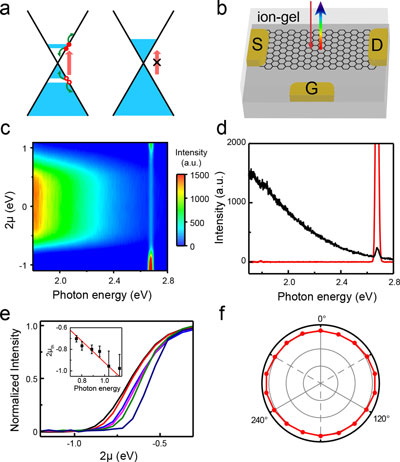| Nov 22, 2018 | |
Gate switching of ultrafast upconverted photoluminescence from monolayer graphene(Nanowerk News) Reporting their findings in Nano Letters ("Gate Switching of Ultrafast Photoluminescence in Graphene"), researchers demonstrated the gate switching of ultrafast photoluminescence in monolayer graphene and analyzed its underlying mechanism both experimentally and theoretically. |
|
| Photoluminescence is one of the most fundamental optical processes and is directly related to the dynamics of photoexcited carriers. Therefore, it is expected to be highly susceptible to electric gating, as has already been demonstrated in semiconducting transition metal dichalcogenide monolayers. | |
| So far, there have been few photoluminescence studies on graphene, because graphene is a semimetallic material with zero bandgap. No photoluminescence upon continuous wave excitations could be observed, unless the graphene is heavily doped to its one-photon Fermi edge resonance. | |
| In contrast to the continuous wave case, in the past researchers have observed a strong, upconverted, ultrafast photoluminescence emerges from undoped graphene upon the femtosecond laser excitation. | |
| In this new work, a team of Chinese scientists investigated this ultrafast photoluminescence from ion-gel gated monolayer graphene and showed that it can be completely switched off by electrical gating with an on/off ratio exceeding 100, due to Pauli-blocking of the one-photon interband transition pathway in heavily doped graphene. | |
 |
|
| Gate tuning of ultrafast photoluminescence in ion-gel gated graphene. (a) Scenarios of optical excitation in undoped and doped graphene, respectively. With the tuning of chemical potential µ, one-photon interband transition could be Pauli-blocked, thus affecting the ultrafast photoluminescence upon femtosecond excitation. (b) Schematic of ion-gel-gated graphene devices. Monolayer graphene was placed on fused silica substrate, while it was covered by ion-gel on the top. S, source electrode; D, drain electrode; G, gate electrode. (c) Photoluminescence spectra from ion-gel gated graphene as a function of chemical potential µ. The excitation wavelength and incident fluence were 1400 nm (0.89 eV) and 3.7 J/m2. The sharp peak at 2.67 eV corresponds to the third harmonic generation signal. All the optical spectra are corrected by the response curve of the detection system. (d) Photoluminescence spectra with chemical potential µ at the CNP (black) and -0.89 eV (red), respectively. (e) Photoluminescence intensity against chemical potential µ. From the left to the right, the excitation photon energy was 1.13 eV (black), 1.034 eV (red), 0.956 eV (blue), 0.888 eV (magenta), 0.794 eV (green), and 0.753 eV (navy). The photoluminescence intensity was integrated from 1.828 eV (680 nm) to 1.883 eV (660 nm). Inset: the switch-off threshold 2 µth as a function of excitation photon energy. The 2 µth is determined by the chemical potential corresponding to 5% of the maximum photoluminescence intensity. To guide the eye, a red solid line with a slope of -1 is plotted. (f) Azimuthal polarization pattern of the ultrafast photoluminescence. (Reprinted with permission by American Chemicval Society) | |
| The team developed a theoretical model to describe the dependence of this photoluminescence to the chemical potential as well as the pump laser fluence, based on a two-temperature distribution of hot carriers and optical phonons. | |
| This first observation of gate-dependent ultrafast photoluminescence in graphene helps to gain insight into the hot carrier ultrafast dynamics in graphene of various doping, and can also provide new opportunities for graphene-based optoelectronic devices and applications. | |
| "With the tuning of chemical potential in a wide range, the phenomenon can provide us with a deeper insight into the hot carrier dynamics in graphene," the authors conclude. "Our study may help the understanding of relevant processes in graphene such as carrier multiplication." | |
| "Furthermore, this strong photoluminescence with its cutting-off behavior near the Fermi edge could be useful in many applications, such as sensing the local dielectric environment of graphene, and other graphene based optoelectronics and optical communication devices." |
 By
Michael
Berger
– Michael is author of three books by the Royal Society of Chemistry:
Nano-Society: Pushing the Boundaries of Technology,
Nanotechnology: The Future is Tiny, and
Nanoengineering: The Skills and Tools Making Technology Invisible
Copyright ©
Nanowerk LLC
By
Michael
Berger
– Michael is author of three books by the Royal Society of Chemistry:
Nano-Society: Pushing the Boundaries of Technology,
Nanotechnology: The Future is Tiny, and
Nanoengineering: The Skills and Tools Making Technology Invisible
Copyright ©
Nanowerk LLC
|
|
|
Subscribe to a free copy of one of our daily Nanowerk Newsletter Email Digests with a compilation of all of the day's news. |
